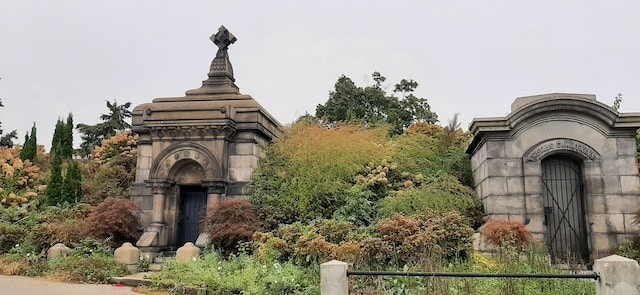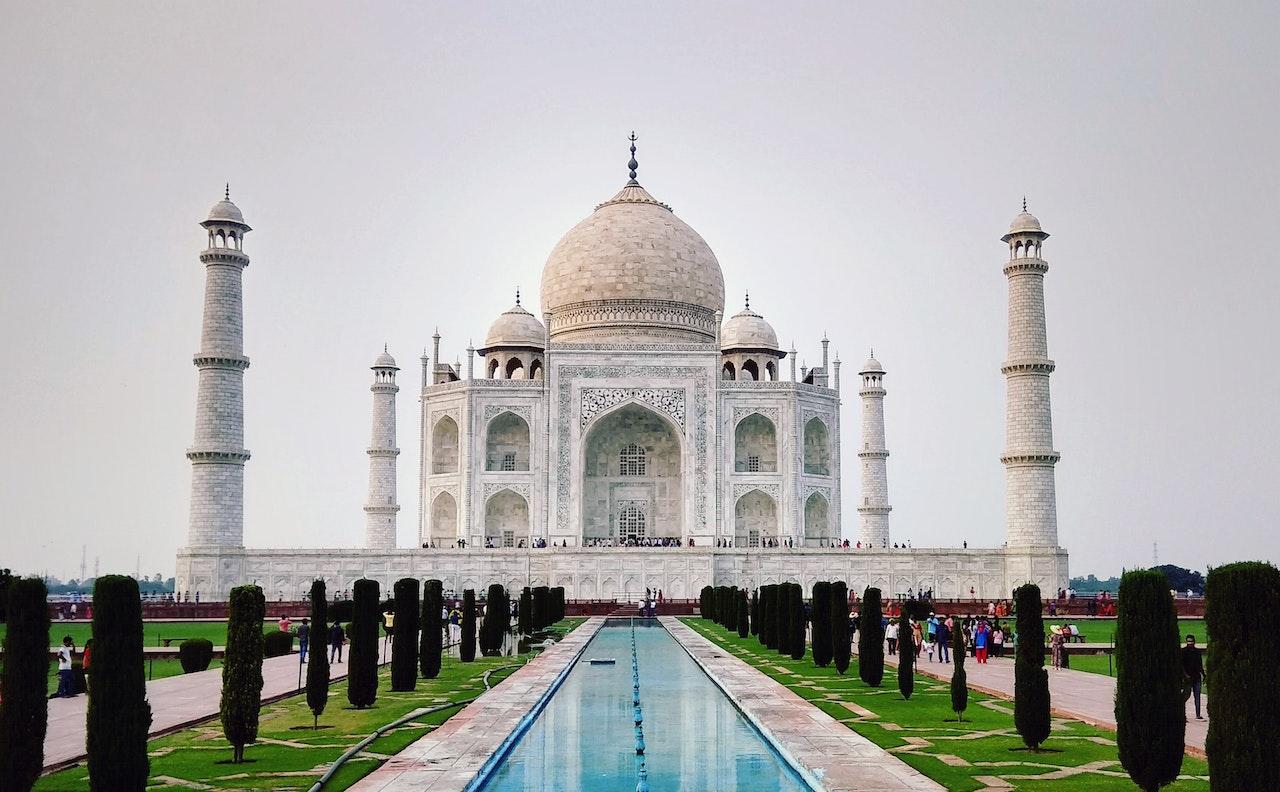For centuries, mausoleums have served as long-lasting memorials for the deceased… But, they are one of the most expensive options for remembering someone. They can be as massive as the Taj Mahal or the Egyptian pyramids – or a modest structure that will still honor the memory of your loved one.
In any case, in this article, you’ll see the benefits and disadvantages of building a mausoleum to make sure it is the best option to honor the memory of the person you love so much.
So… What is a mausoleum?

Photo by shravan khare
A mausoleum is an above-ground structure created to securely house one or more deceased individuals. The remains are interred in crypts or niches within the walls of the mausoleum, providing more security and longevity.
In addition, mausoleums often incorporate artistic and architectural elements in their design that significantly increase their value. In fact, many of the great structures such as Castel Sant Angelo or the Panthéon in Paris are clear examples of how impressive these structures can be.
Affluent families throughout history commissioned mausoleums whose luxurious appearances became symbols of cultural significance as well as social status – and today, they continue to be an excellent choice for people to leave a legacy that will last for centuries… Or even millennia!
What’s the purpose of a mausoleum?

Photo by RDNE Stock project
The purpose of a mausoleum is to hold the remains of a deceased person, either in bodily or cremated form. It is the perfect way to leave a legacy as well as an artistic structure of outstanding beauty that will highlight and honor the deceased.
Moreover, the family’s beliefs, values, and tastes are reflected in the design of these beautiful structures. It makes mausoleums unique in their style.
However, there are different types of mausoleums. Some of them are:
Family mausoleums
A single-family or lineage can have their remains housed in these private mausoleums. They can be multi-chambered buildings with space for multiple generations, or simple structures with a few crypts.
They are usually made of durable materials like granite or limestone, which guarantees they last long and can be used for several generations without major repairs.
Most mausoleums are found in cemeteries, but you may also find some near religious buildings, or even on private land.
Public mausoleums
Public mausoleums are available for families who cannot afford to build their own. Visitors can come indoors to pray while viewing the sealed crypt of their loved one.
They are designed to house the remains of multiple individuals, regardless of their relation. So, public mausoleums provide a range of crypt and niche choices to accommodate different needs and preferences, including single or companion spaces.
Church mausoleums
These mausoleums are usually built for religious communities within or near a religious facility like a church or temple. They offer a spiritual environment for the interred and their families, with religious artwork, symbols, spaces for prayer and reflection, as well as crypts and niches.
Garden mausoleums
Although garden mausoleums are available for public interment, they lack an indoor space for mourners to gather and reflect. Each crypt’s door opens to the outside.
Thus, it is a public mausoleum that blends seamlessly with its surrounding landscape, which often includes lush greenery, water elements, and walking paths. Visitors can remember and honor their loved ones in a serene and natural setting provided by these outdoor mausoleums, which may have open-air corridors, courtyards, or terraces.
How much does it cost to build a mausoleum?

Photo by shravan khare
The cost of the mausoleum will vary based on its size, design, materials, and location. Expensive materials such as marble, granite, or limestone, as well as intricate architectural elements or custom artwork can add up to the cost.
On average, a small mausoleum can cost around $300,000 to $600,000 – and a mausoleum like the Taj Mahal could cost more than $30 million.
However, the cost of purchasing a crypt or niche in a public or church mausoleum is less expensive, and it might be as affordable as $2000. Their prices can vary depending on factors such as location, size, and availability.
In addition, to maintain their appearance and structural integrity, mausoleums need regular maintenance. Cleaning, repairs, landscaping, and pest control can all be part of this, which can increase their cost anyway, and have an annual maintenance fee to cover these costs.
Pros and cons of mausoleums
To evaluate if a mausoleum fits your needs, you’ll have to evaluate the pros and cons:
Pros
Cons
Choosing the right mausoleum

Photo by Arun Sharma
When choosing a mausoleum for yourself or for dealing with the loss of a loved one, there are several important factors to take into account.
It is essential to consider the accessibility of the mausoleum’s location so that family members and friends can easily visit and pay their respects. Keep in mind the number of people you want to accommodate, as family mausoleums can be created to hold multiple generations, while public or church mausoleums provide different options for crypts and niches.
In addition, mausoleums are available in a vast array of architectural styles, materials, and designs to suit individual preferences. Take into account your esthetic preferences and any cultural, religious, or personal symbolism you wish to include. Collaborating with a skilled architect or designer can bring your ideas to fruition while guaranteeing the mausoleum’s durability and stability.
Having a clear understanding of your budget and associated costs is also essential when considering mausoleum burial, as it can be a significant investment.
Famous mausoleums from around the world
Throughout history, various cultures and periods have had numerous famous mausoleums, each with its unique architectural style and historical significance. Some noteworthy mausoleums are:
Taj Mahal (India)
 Photo by Roney John
Photo by Roney John
An architectural marvel and iconic symbol of love, the Taj Mahal was built between 1631 and 1653 by Mughal Emperor Shah Jahan in memory of his wife Mumtaz Mahal. A must-see attraction in India is the white marble mausoleum, which is adorned with intricate carvings, precious stones, and calligraphy and is a UNESCO World Heritage Site.
The Great Pyramid of Giza (Egypt)
 Photo by Mouad Mabrouk
Photo by Mouad Mabrouk
Pharaoh Khufu’s tomb was constructed as the oldest and largest of the three pyramids in the Giza pyramid complex, known as The Great Pyramid of Giza in Egypt. The Egyptians’ advanced engineering capabilities and their reverence for the afterlife are showcased in this ancient wonder of the world, despite it not being a traditional mausoleum.
Castel Sant’Angelo (Italy)
 Photo by Maximilian K
Photo by Maximilian K
Castel Sant’Angelo in Italy was originally constructed as a mausoleum for the Roman Emperor Hadrian and his family in 139 CE. It has undergone numerous transformations throughout the centuries. A fortress, a papal residence, and a prison have all been served by it, and now it operates as a museum. A prominent landmark in Rome, it has a unique cylindrical design and a rich history.
Lenin’s Mausoleum (Russia)

Mauzoleum Lenina by Staron. Public domain
The final resting place of Vladimir Lenin, the leader of the Russian Revolution and the first head of the Soviet Union, is located in Moscow’s Red Square at Lenin’s Mausoleum. A striking example of Soviet architecture, the mausoleum was built in 1930 and serves as a historical reminder of Russia’s turbulent past. The mausoleum still publicly displays Lenin’s embalmed body.
The Pantheon (France)

The Panttheon by Moonik. Public domain
Located in the heart of Paris, the Pantheon is a grand neoclassical mausoleum. Originally built as a church dedicated to St. Genevieve, it was repurposed as a mausoleum during the French Revolution. The Pantheon is famed for its spectacular architecture, specifically its colonnaded facade and domed roof, which was inspired by the Pantheon in Rome. Inside, it hosts the remains of many of France’s most illustrious individuals such as Voltaire, Rousseau, Victor Hugo, Emile Zola, and Marie Curie.
Mausoleum of Augustus (Italy)

Mausoleum of Augustus by MumblerJamie. Public domain
The Mausoleum of Augustus, situated in Rome, Italy, is a large circular tomb built by the Roman Emperor Augustus in 28 BC. The structure, which was once adorned with lush gardens and sculptures, is a significant monument of the Augustan era. It has served as the final resting place for Augustus and several family members, including his wife Livia and the emperors Tiberius and Claudius.
Photo by RODNAE Productions

